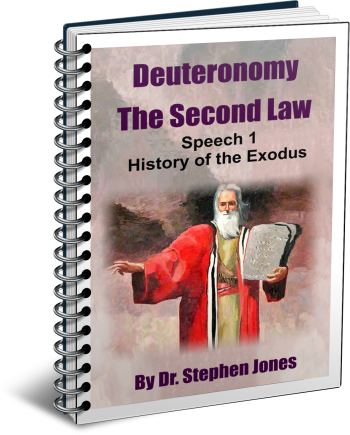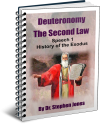Latest Posts
View the latest posts in an easy-to-read list format, with filtering options.

A commentary on the first speech of Moses in Deuteronomy 1-4. The book of Deuteronomy is a series of 12 speeches that Moses gave just before his death at the end of Israel's wilderness journey.
Category - Bible Commentaries

Deuteronomy 2:10-13 is a parenthetical notation that probably was not part of Moses' speech.
10 (The Emim lived there formerly, a people as great, numerous, and tall as the Anakim. 11 Like the Anakim, they are also regarded as Rephaim, but the Moabites call them Emim. 12 The Horites formerly lived in Seir, but the sons of Esau dispossessed them and destroyed them from before them and settled in their place, just as Israel did to the land of their possession which the Lord gave to them.)
This short historical explanation appears to have been inserted by Ezra in his inspired canonization of the Old Testament. Ferrar Fenton says this in his notes:
Vv. 10 to 13 are an ancient editor's note, not a part of the text of Moses. It was probably added by Ezra, when he edited the Pentateuch, after the return from Babylon, as all the other notes which I consequently transfer to the foot of the pages.
Even if this is so, there is no reason why Ezra's notation is less “inspired” than the rest of Moses' speech. Ezra was simply explaining how the Moabites came to dispossess the Emim and take their territory as an inheritance. Verse 12 continues by telling us how the Edomites dispossessed the Horites living in Mount Seir. I consider this to be a divinely inspired supplement to give some background to Moses' account.
So who were the Emim? Ezra implies that they were giants like the Anakim. In Num. 13:33 the twelve spies reported seeing the sons of Anak (or Anakim) in the land of Canaan. Their progenitor, Anak himself, was the son of Arba, who founded and settled the town of Hebron. Hebron's original name was Kirjeath Arba (Joshua 15:13), which may be translated “City of Arba.” Later, Caleb and his men drove them out and inherited their land (Joshua 14:13; 15:14).
The Emim were another family of giants who lived east of the Dead Sea until they were displaced by the Moabites. Ezra says in verse 11, “like the Anakim, they are also regarded as Rephaim.” Who were the Rephaim? The KJV translates it as “giants.”
Rephaim is the plural of Rapha, which means “healer; mender” in the sense of stitching together. Originally, the word had reference to the “sons of God” cohabiting with the “daughters of men” in Genesis 6:4. In other words, two different types of beings were stitched together in unlawful marriages, which produced giants in the earth.
The term “sons of God” has various meanings, but in this case it means angels. That term, too, can have a variety of meanings, but we leave that to the opinion of the reader.
These giants are known by various other names, such as Nephilim, which means “fallen ones.” (The singular form is naphal, “to fall.”) Hence, there arose a very ancient belief about angels who fell. Genesis 6:4 calls them Gibbor, “mighty men.” Scripture tells us that these giants lived prior to Noah's flood, and that the purpose of the flood was to destroy them, because they had corrupted the genetics of mankind, except for Noah and his family (Gen. 6:9).
Genesis 6:2 speaks of these unlawful unions prior to the flood. Genesis 6:4 also tells us that this same genetic corruption occurred again after the flood.
4 The Nephilim were on the earth in those days [prior to the flood], and also afterward, when the sons of God came into the daughters of men, and they bore children to them. Those were the mighty men [Gibbor] who were of old, men of renown.
There were, then, at least two occasions when this sin occurred—one prior to the flood, and later after the flood. This was why the Nephilim were yet living in the days of Moses and Joshua.
Centuries later, we find Goliath and his three brothers living in Gath, a city of the Philistines. All were “giants” (Heb. Rephaim), and they were all killed by David and his mighty men (2 Sam. 21:22).
Returning to our topic in Deut. 2:10-12, we are told that the Moabites called these giants Emim. What does that name mean? The Wikipedia has only a short article about them:
The Emim; Hebrew: ??????) was the Moabite name for one of the tribes of Rephaim. They are described in Deuteronomy chapter 2 as having been a powerful people, populous and having a successful kingdom. They were defeated by the Moabites, who occupied their land. The Emim are also mentioned in Genesis 14:5 and according to Rashi, the name is translated as “the dreaded ones” (Hertz 1936) and the singular Ema/Emma (Hebrew: ????) means “horror” or “terror”.
(http://en.wikipedia.org/wiki/Emim)
So we see that the Emim were terrorists. This is of interest to us today, because world attention has been focused increasingly upon the problem of terrorism in recent decades. When we apply this factor to the present day, we can view Moab and the Emim as overlaying each other in prophecy, because the land of Moab was also the land of the Emim.
In other words, the time of Moab’s immorality in the Church coincides with the rise of terrorism. Both arose in the early 1960’s.
The Emim were largely destroyed by the coalition of Babylonian kings in Genesis 14, when also Sodom and Gomorrah were captured (along with Lot, Abraham's nephew). Abraham and his 318 men chased these kings to Hobah, near Damascus, and defeated them. Lot was set free along with the other captives, but just 24 years later God Himself destroyed Sodom and Gomorrah.
At that time, Lot's daughters bore children by their own father, and one of them, Moab, later grew up, got married, had children, and moved east to settle the land where the Emim had lived previously. In other words, God used the Babylonians to wipe out the “terrorists,” clearing the way for the Moabites to inhabit their land.
This story applies to us today in the prophetic sequence of events. In 1948 we began our detour around Edom. This was followed by the rise of immorality as we encountered Moab in the sexual revolution in the 1960’s. Rising simultaneously with immorality was the rise of terrorism as a method of war.
Deut. 2:12 tells us that “the Horites formerly lived in Seir.” (See also Gen. 14:6.) Scripture does not tell us how Esau came to dispossess the Horites in the land of Seir, but we find Esau living in Seir when Jacob returned home after living with Laban for 20 years. Recall that Esau met Jacob on the return trip, when Jacob sent word to his brother as a gesture of reconciliation. Gen. 32:3 says,
3 Then Jacob sent messengers before him to his brother Esau in the land of Seir, the country of Edom.
After the brothers had reconciled, Esau returned to Seir (Gen. 33:16), where he obviously had settled during the time Jacob was with Laban. The book of Jasher 30:26 tells us the reason. Esau's flocks and herds were too great, and his herdsmen were disputing with the Canaanites. So Esau moved permanently to Seir, being allied with the Horites.
Isaac died 23 years later, and according to Jasher 47, his estate (wealth) was taken by Esau in exchange for the land of Canaan, which was given to Jacob. We are also told in Jasher 57 that after the death of Jacob and Esau, the sons of Esau had a falling out with the Horites. The Horites asked them to leave their territory, at which time, the sons of Esau wiped out the Horites and took Mount Seir for themselves as their inheritance (57:36).
Since the Bible does not record the circumstances by which Edom came to possess Mount Seir, we must rely upon the book of Jasher for that information.